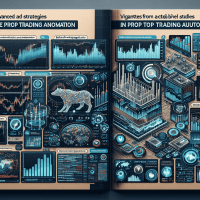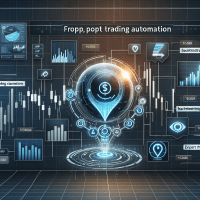Proven Prop Trading Automation: Advanced Backtesting Insights
The world of proprietary trading is rapidly evolving with the adoption of cutting-edge automation tools and advanced backtesting methodologies. In this article, we dissect the critical strategies behind prop trading automation, offering insightful comparisons of top-tier tools, actionable tips for effective backtesting, and expert guidance tailored for traders at every level. Whether you are a junior trader, a senior quant, or a risk manager, this comprehensive guide provides the depth of analysis needed to optimize your trading systems while adhering to regulatory standards.
Understanding Prop Trading Automation
Prop trading automation merges algorithmic trading with advanced backtesting, enabling firms to test strategies on historical data and simulate market conditions. This process minimizes risks such as overfitting, survivorship bias, and look-ahead bias, ensuring that strategies perform well in real-time conditions. Key elements include:
- Algorithmic Trading Solutions: Automated systems that execute trades based on predetermined criteria.
- Advanced Backtesting: Using historical data to simulate and optimize trading strategies.
- Risk Management: Techniques to balance portfolios and mitigate losses, complying with regulations like MiFID II and ESMA.
With these fundamentals in place, prop trading firms can enhance the precision of their trading models and better manage market volatility.

Figure 1: Screenshot of an advanced prop trading dashboard displaying automated backtesting reports and key performance metrics.
Key Advanced Backtesting Concepts for Prop Trading
Mitigating Common Backtesting Pitfalls
Backtesting is not without challenges. Traders often struggle with pitfalls such as:
- Overfitting: Excessively tailoring strategies to historical data, risking poor real-world performance.
- Survivorship Bias: Relying solely on data that includes only surviving assets or strategies, skewing results.
- Look-ahead Bias: Utilizing future data in the model, which is not available in real-time trading.
- Data Snooping: Excessive optimization leading to false signals and non-generalizable strategies.
Pro Tip: Use a combination of walk-forward optimization and out-of-sample testing to ensure robustness. Walk-forward analysis allows you to adjust for changes over time, while out-of-sample tests ensure your strategy performs in unseen data periods.
Integrating Backtesting with Forward Testing
While backtesting forms the backbone of strategy development, integrating it with forward testing (paper trading) is essential. This process involves:
- Paper Trading: Simulating trades in a live or simulated environment without financial risk.
- Real-Time Monitoring: Continuously tracking performance metrics such as Sharpe ratio and maximum drawdown.
- Scenario Analysis: Stress testing trading strategies under varied market conditions.
Traders should monitor key performance metrics like Profit Factor, Sharpe Ratio, and Maximum Drawdown to quantify strategy performance. For example, a Sharpe ratio above 1.0 is generally considered profitable in volatile markets.
Comprehensive Tool Comparisons for Prop Trading Automation
Choosing the right automated backtesting and trading platform is crucial. Here, we compare three widely recognized tools designed for both team-based prop trading and individual retail traders:
| Tool | Backtesting Features | Data Availability & Quality | Integration Capabilities | Pricing & Use Cases |
|---|---|---|---|---|
| TradingView | Event-driven backtesting, integrated Pine Script for custom strategy testing, commission/slippage adjustments. | Comprehensive historical data; covers various asset classes with real-time feeds. | API access, broker integration, interactive charting supports prop firms and retail traders. | Affordable monthly tiers with free trials, ideal for beginner to intermediate traders. |
| MetaTrader 5 | Vectorized backtesting, robust optimization, handles spread and execution nuances. | High-quality historical tick data across forex, stocks, and commodities. | Seamless integration with multiple brokers and third-party plugins, widely used in prop firms for scalability. | Free version available for retail traders; proprietary pricing for professional versions, excellent for advanced algorithmic trading. |
| NinjaTrader | Advanced backtesting to model complex strategies, includes stress testing features. | Rich historical and real-time market data, covering futures, forex, and equities. | Extensive API and broker integrations, support for multi-user environments ideal for prop trading teams. | Flexible pricing model with licensing options, suitable for both individual experts and firm-level operations. |
Industry Insight: Each platform offers distinct advantages depending on firm size and trading style. For instance, while TradingView is highly accessible and cost-effective for beginners, MetaTrader 5 and NinjaTrader provide deep customization and advanced backtesting features critical for larger prop firms.
Real-World Case Study: Enhancing Strategy Robustness
Consider a well-known prop trading firm that was testing a high-frequency trading strategy using MetaTrader 5. They encountered challenges with data inconsistencies and overfitting during backtesting. By integrating walk-forward optimization and rigorous out-of-sample analysis, the firm improved its Sharpe ratio from 0.8 to 1.2 and reduced the maximum drawdown by 15%.
They leveraged NinjaTrader’s advanced stress testing and scenario analysis features to simulate market shocks. The integration of automated parameter optimization allowed for rapid iterations, significantly shortening strategy development cycles. This case underscores the importance of using advanced backtesting tools to refine trading models and simultaneously manage risk—a lesson applicable to both small trading teams and large prop firms.
Implementing Automation with Expert-Driven Strategies
Step-by-Step Guide for Integrating Backtesting Tools
Implementing a robust prop trading automation strategy involves several steps:
- Select the Right Platform: Evaluate platforms like TradingView, MetaTrader 5, and NinjaTrader based on your unique backtesting needs and team structure.
- Data Sourcing: Ensure your historical data, whether tick or bar data, is of high quality by considering sources that adjust for corporate actions and missing values.
- Run Preliminary Backtests: Use a sample set of data to rule out common pitfalls such as overfitting. Adjust parameters and optimize strategy performance over iterative cycles.
- Integrate Forward Testing: Transition successful backtested strategies to paper trading environments using platforms’ simulation modes to monitor real-time performance.
- Analyze & Optimize: Utilize detailed reports and performance metrics to refine the strategy further. Look into scenario analysis and walk-forward optimization features.
Below is a sample Python code snippet using the Backtrader framework, which exemplifies a simple automated trading strategy:
import backtrader as bt
class TestStrategy(bt.Strategy):
def __init__(self):
self.sma = bt.indicators.SimpleMovingAverage(self.data.close, period=20)
def next(self):
if self.data.close[0] > self.sma[0] and not self.position:
self.buy()
elif self.data.close[0] < self.sma[0] and self.position:
self.sell()
cerebro = bt.Cerebro()
# Load data here
# data = bt.feeds.YahooFinanceData(dataname='AAPL', fromdate=datetime(2020, 1, 1), todate=datetime(2021, 1, 1))
# cerebro.adddata(data)
cerebro.addstrategy(TestStrategy)
result = cerebro.run()
cerebro.plot()
This backtesting example demonstrates how traders can programmatically implement and assess strategies. Such automation is key in ensuring that a trading strategy can withstand real market conditions before live deployment.

Figure 2: Detailed backtesting report from MetaTrader 5 highlighting performance metrics, optimization results, and risk analysis.
Expert Guidance and Next Steps
For traders looking to leverage prop trading automation, the next logical step is to audit your current trading systems against the principles outlined here. Consider these expert tips:
- Perform Regular Strategy Reviews: Backtesting is an ongoing process. Continuously evaluate both historical and live performance to stay ahead of market changes.
- Invest in Quality Data: Use reliable data sources to ensure your backtesting results mirror potential real-world outcomes. Inconsistent data quality can lead to poor decision-making.
- Educate Your Team: Whether you are a dealer, trader, or risk manager, staying updated with regulatory changes and advanced backtesting methodologies is crucial.
Internal Links: For further insights, check out our articles on Risk Management in Prop Trading and Understanding Quantitative Strategies.
As prop trading continues to integrate advanced technologies, staying informed and agile is paramount. Sign up for our upcoming webinar to receive a comprehensive Risk Management Checklist and gain access to exclusive resources on optimizing your trading approaches.
Conclusion
Prop trading automation, underpinned by state-of-the-art backtesting methodologies, is reshaping how trading strategies are developed and executed. By leveraging platforms like TradingView, MetaTrader 5, and NinjaTrader, and by rigorously applying best practices in data management and optimization, traders can achieve greater precision and risk control in their strategies.
Ultimately, the future of prop trading lies in continuous innovation and learning. Embrace these advanced techniques to stay ahead of the curve and transform your trading performance.
As of October 2023, these insights equip you with the knowledge to refine your trading strategies and achieve sustainable success.







